Are you also a golf mystery solver looking to find the solution to what is a golf handicap? For beginner golfers, golf handicap has always been an enigma. A golf handicap is the average score or number of strokes a golfer shoots over par. Golf handicaps offer a level playing field to all golfers.
In golf, fair play is the prime objective of the golf game. If you are an absolute newbie who wants to play with a scratch golfer, YOU CAN. You might even beat him in the net score. Thanks to the golf handicap system, it lays a fair playing field. A golf handicap has further metrics like course handicap, handicap index, course rating, slope rating, bogey rating, and handicap differential.
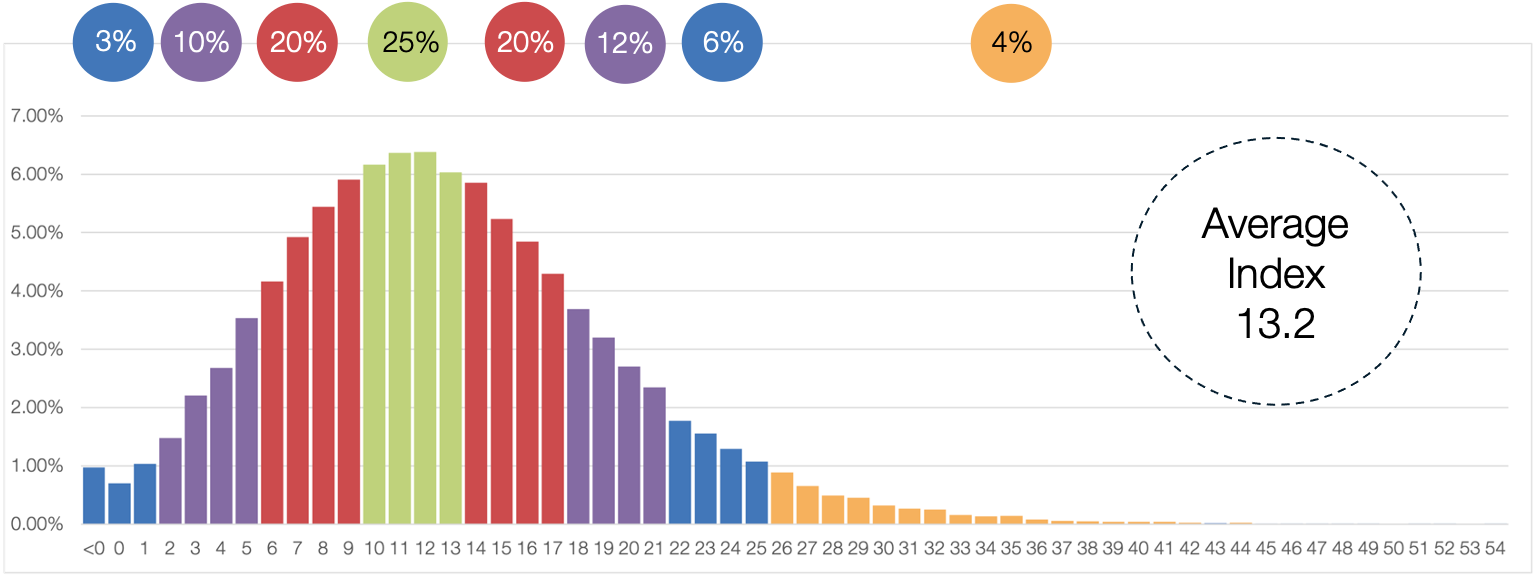

Intrigued? Let’s learn all the principal concepts about golf handicaps. We will cover all golf handicap-associated terminologies that a new golfer comes across. United States Golf Association (USGA) updated the unified handicapping system also known as the new World Handicap System (WHS) in 2020.
Official Definition of the Golf Handicap Index
Before we move on, it is pertinent to state the official definition of the golf handicap based on authoritative golf sources.
| Source | Definition |
|---|---|
| USGA | The measure of a player’s demonstrated ability is calculated against the Slope Rating of a golf course of standard playing difficulty (that is, a course with a Slope Rating of 113). |
| Wikipedia | A golf handicap is a numerical measure of a golfer’s ability or potential ability, that is used to enable players of different abilities to compete against one another. Better players are those with the lowest handicaps |
| United States Golf Teachers Federation | Golf Handicapping, as in horse racing, allows players of differing abilities to compete on an equitable basis with each other. Each player is assigned a handicap index that results from the scores recorded for that player, is revised over time, and moves up or down as the player submits scores and his game changes. |
Brief Historical Timeline of the Golf Handicap
Throughout its history, the golf handicap has evolved from informal arrangements to sophisticated, standardized systems that enhance the inclusivity and fairness of the game on a global scale.
| Time | Progress |
|---|---|
| Late 19th Century | The concept of a golf handicap began to emerge in the late 19th century. Golf clubs and societies started to use informal systems to allow players of varying skill levels to compete more evenly. |
| 1911 | The USGA introduced the first official handicap system in the United States as the USGA Handicap System. This system aimed to standardize and formalize the way golfers’ abilities were assessed. |
| 1920s-1930s | The concept of a handicap spread internationally, with golf associations in various countries adopting similar systems. |
| 1987 | The USGA introduced the Slope Rating system, designed to account for the relative difficulty of different golf courses. This system helped to standardize handicaps across courses with varying levels of difficulty. |
| 1980s-1990s | Handicap systems became more computerized, allowing for more efficient and accurate calculations. |
| 2000s | Digital technologies, including online platforms and mobile apps, made it easier for golfers to track and manage their handicaps. |
| 2020 | The World Handicap System (WHS) was developed as a collaboration between the USGA and the R&A (Royal & Ancient Golf Club of St Andrews), unifying handicap systems worldwide. This system takes into account factors like course rating, slope, and playing conditions to calculate a golfer’s Handicap Index. |
| Present | Golf handicaps continue to be a fundamental part of the sport, allowing players of different skill levels to compete on an equitable basis. Ongoing advancements in technology contribute to the accessibility and accuracy of handicap calculations. |
How Does Golf Handicap Work?
Before we move on to how to calculate your handicap, let’s dig into an example that will show you how a golf handicap works. This will be significant in grasping the subject matter.
Suppose we have 4 golfers named A, B, C, and D. They all have different handicaps ranging from low handicaps to high handicaps.
| Golfer | A | B | C | D |
|---|---|---|---|---|
| Gross Score | 79 | 94 | 83 | 89 |
| Handicap | 6 | 20 | 14 | 16 |
| Net Score | 73 | 74 | 69 | 74 |
| Position | 2 | T3 | 1 | T3 |
If you analyze this table, golfer B shot the most strokes over par, and golfer A shot the least strokes. However, Golfer A became second after calculating the net score, and Golfer C became first even after scoring 11 over par.
The overall average score in terms of gross score is 86.25. Whereas the overall average net score is 72.50. This shows that a golf handicap index is a fair equalizer in the game.
In the chart below, you can see the latest golf handicap index distribution of men and women. It will give you a clear idea of what is the most common handicap among registered golfers in the United States.
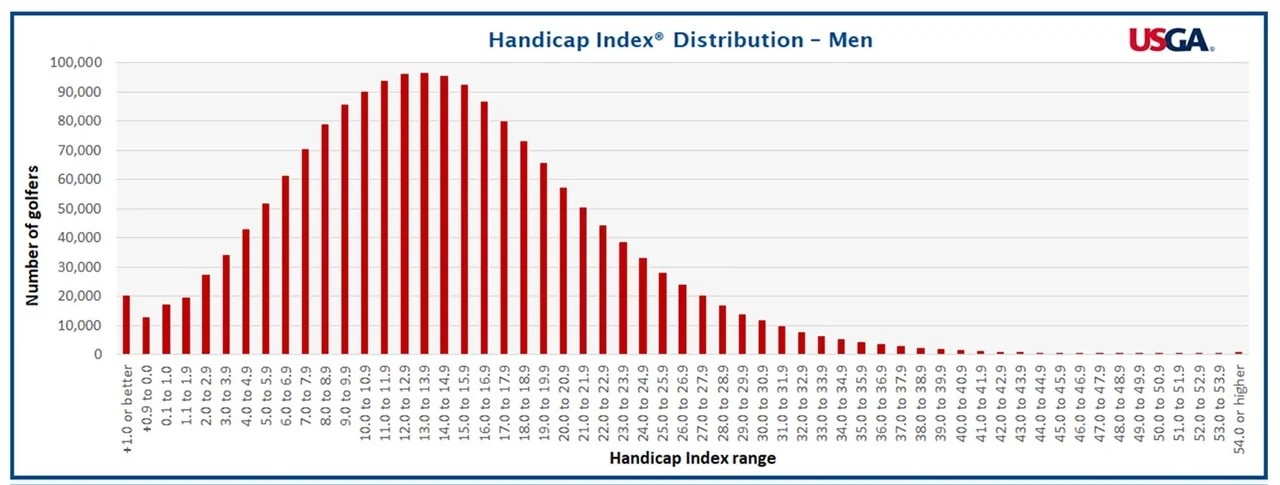

This graph depicts that almost 180,000 male golfers have a handicap index of 12-14. This is the average handicap of male golfers.
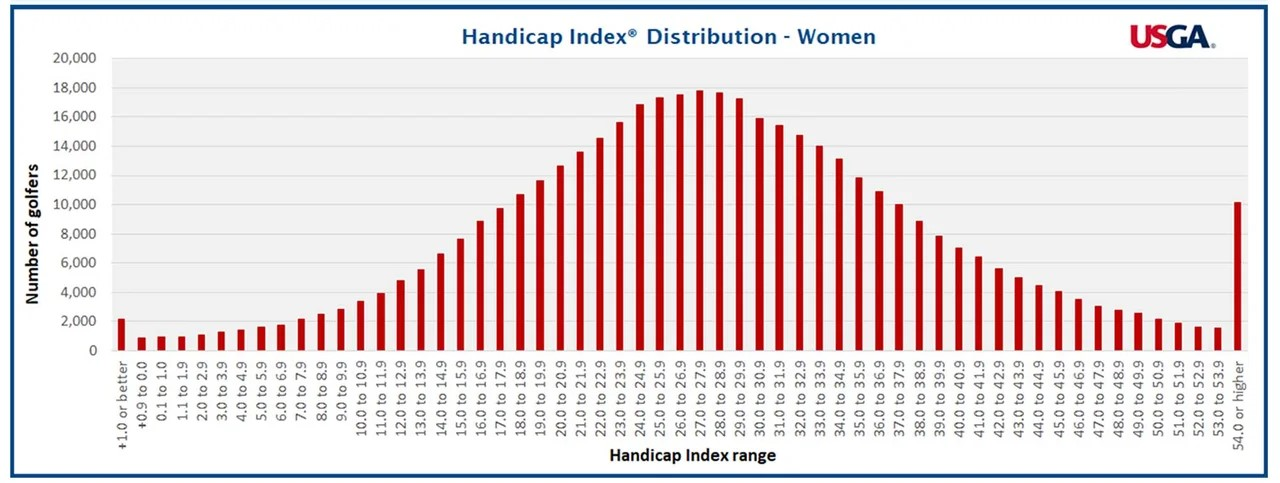

This graph depicts that almost 18,000 female golfers have a handicap index of 27-28. This is the average handicap of women golfers.
How to Calculate Your Golf Handicap Index
We have a detailed step-by-step article on how to calculate your golf handicap including factors like course handicap, course rating, slope rating, bogey rating, and handicap differential. Nevertheless, there are three ways you calculate handicaps.
- Let your local golf association or golf club calculate it for you from your last 3 scorecards.
- Get it calculated from any digital golf app. Visit this if you want to know the best golf apps for iPhone and Android.
- Calculate it yourself.
But how to calculate it yourself? Below we will share different formulas for handicap calculation and explain them briefly.
Calculate Handicap Differential
The handicap differential is a specific calculation for an individual round of golf on a particular course. The differential reflects the player’s performance concerning the difficulty of the course played on that specific day.

Adjusted Score: The adjusted score (net score) is the adjusted gross score (total strokes after applying for any handicap allowances).
Course Rating: Course rating is the difficulty rating of the course.
Slope Rating: Slope rating accounts for the relative difficulty of the course for bogey golfers.
Following are the slope ratings of some of the most famous golf courses
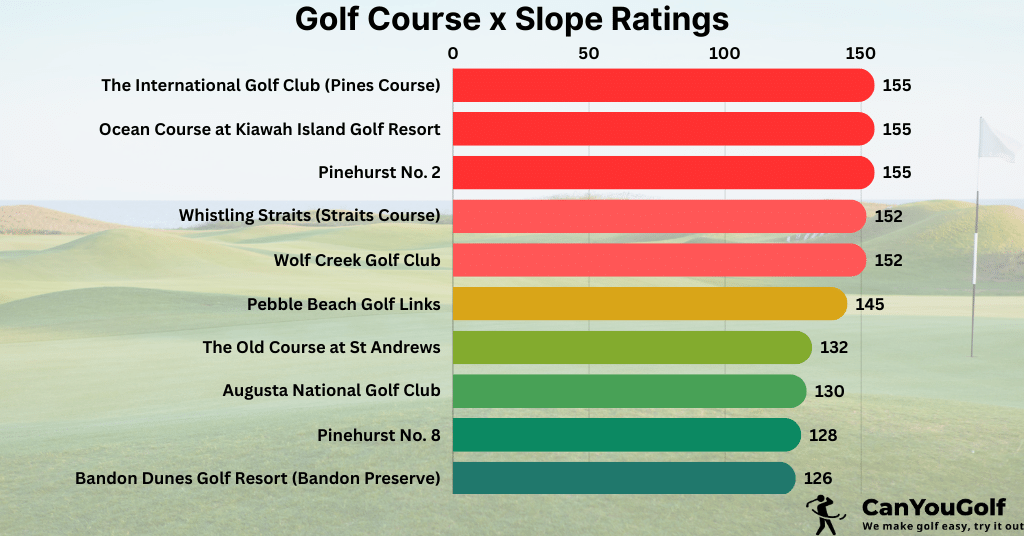

Calculate the Handicap Index
The handicap index is an average of the best differentials from recent rounds, adjusted for consistency and fairness. It is calculated by taking the average of the lowest differentials, multiplying by 0.96, and rounding to one decimal place. The handicap index represents a player’s potential ability and is used as a baseline for calculating the course handicap for specific courses.
| Number of Rounds | Differentials to Use | Adjustment to Average |
|---|---|---|
| 3 | lowest 1 | -2.0 |
| 4 | lowest 1 | -1.0 |
| 5 | lowest 1 | 0 |
| 6 | lowest 2 | -1.0 |
| 7 or 8 | lowest 2 | 0 |
| 9 to 11 | lowest 3 | 0 |
| 12 to 14 | lowest 4 | 0 |
| 15 or 16 | lowest 5 | 0 |
| 17 or 18 | lowest 6 | 0 |
| 19 | lowest 7 | 0 |
Here n is the number of differentials and adjustment is available in the table above.
Determine the Lowest Differentials
From the most recent 19 handicap differentials, select the 7 lowest handicap differential.
Average the Lowest Differentials
Average the lowest 7 differentials.
Apply Adjustment
You can apply the relevant adjustment from the table above or multiply the average by 0.96 to obtain the Handicap Index. The factor 0.96 is used to control the impact of exceptionally good rounds on the average. It is intended to provide a balance between responsiveness to good play and stability in the handicap index.
By applying this adjustment, golf associations aim to smooth out potential fluctuations caused by a single outstanding performance, promoting a more accurate representation of a golfer’s overall ability based on a reasonable sample of recent rounds.
Calculate Course Handicap

This gives the player’s handicap for a specific course.
Determine Stroke Index
To make it more even, you can determine the stroke index. Let’s consider a golf course with 18 holes, each assigned a stroke index from 1 to 9. The stroke index indicates the difficulty of each hole for the average golfer. Here’s an example:
| Hole | Stroke Index |
|---|---|
| 1 | 10 |
| 2 | 4 |
| 3 | 16 |
| 4 | 6 |
| 5 | 14 |
| 6 | 2 |
| 7 | 12 |
| 8 | 8 |
| 9 | 18 |
In this example, Hole 9 has the highest stroke index of 18, indicating it is considered the most challenging hole. Golfers with a golf handicap would receive strokes on the holes with higher stroke indexes.
For instance, if a golfer has a golf handicap of 10, they would receive one stroke on Holes 1, 3, 5, 7, and 9, as those are the holes with the ten highest stroke indexes. This stroke allocation helps to level the playing field, allowing golfers of different skill levels to compete more equitably on a given course.
Maximum Hole Score
For handicap purposes, a maximum score per hole is usually set (e.g., Net Double Bogey). The concept of a Maximum Hole Score is a provision in the handicap system designed to prevent exceptionally high scores on individual holes from disproportionately affecting a golfer’s handicap.
The usual standard is set at “Net Double Bogey,” which means the maximum number of strokes a golfer can record for handicap purposes on a specific hole is limited to a score that is two strokes over par, adjusted for their course handicap.
Following is the table as per USGA Equitable Stroke Control:
| Course Handicap | Maximum Score |
|---|---|
| Nine or less | Double Bogey |
| 10-19 | 7 |
| 20-29 | 8 |
| 30-39 | 9 |
| 40 and above | 10 |
Example Scenario
Consider a hole with a par of 4. Applying the Net Double Bogey adjustment principle, the maximum allowable score would be 6 strokes (4 for par plus 2). For instance, if Golfer John possesses a course handicap of 10 and encounters a hole with a par of 4, the maximum score considered for handicap purposes would be 6 strokes.
| Golfer | Par | Gross Strokes | Strokes Over Par | Maximum Hole Score | Adjusted Score |
|---|---|---|---|---|---|
| John | 4 | 8 | 4 | 6 (Net Double Bogey) | 4+6 (Par+Maximum Hole Score) = 6 |
This ensures that outlier scores do not unduly influence a golfer’s handicap, striking a balance between fairness and the evaluation of overall performance on each hole. This helps a lot if you are a bogey golfer.
By following these steps and using the provided formulas, golfers can accurately calculate their handicap, adjusting for the difficulty of the courses they play according to their skill levels.
Golf Scoring Range and Probabilities
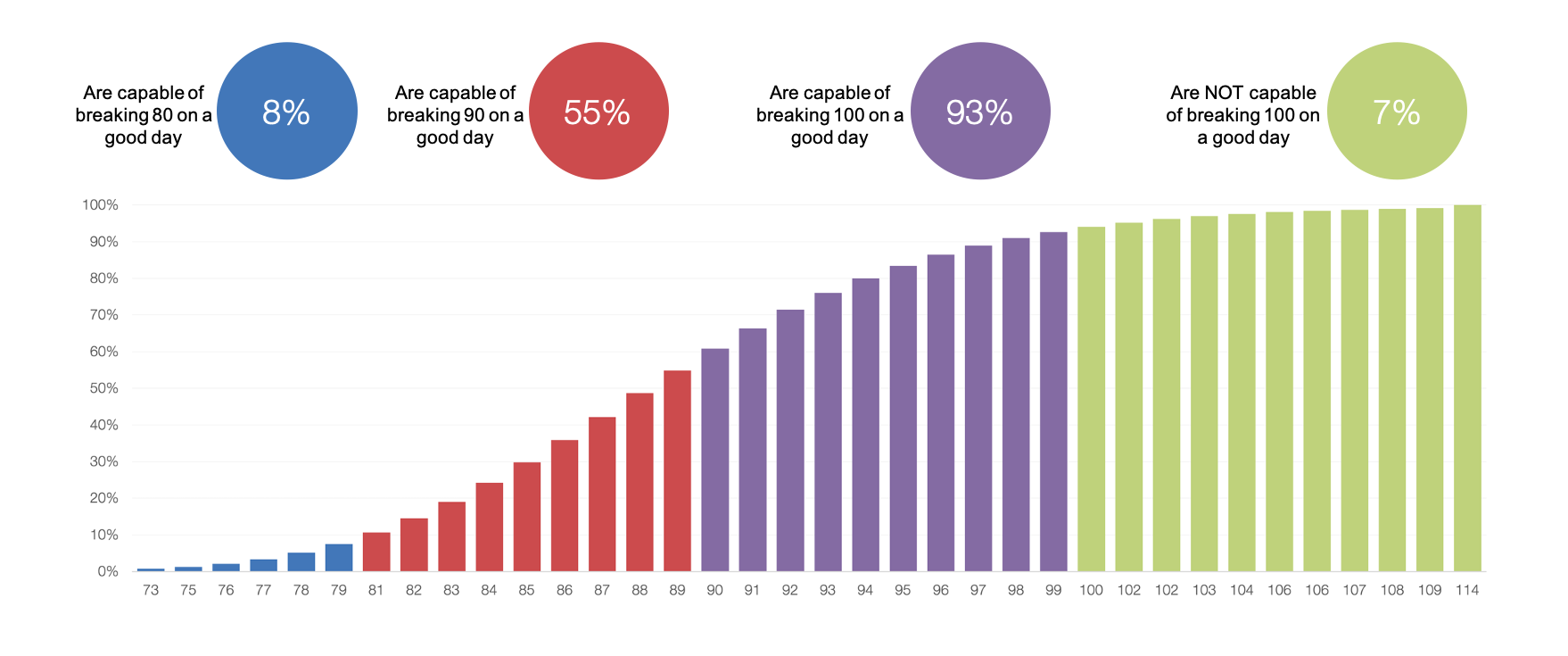

People Also Ask
What is a Golf Handicap in Simple Terms?
A golf handicap, in simple terms, is a numerical measure of a golfer’s playing ability. It allows players of different skill levels to compete on a more even basis.
How Do You Figure Out Your Handicap in Golf?
To figure out your golf handicap, submit scorecards to the handicap system or calculate your Handicap Index using the standard handicap calculation formulas.
Who is a Scratch Golfer?
If a golfer’s handicap index is zero, he is considered to be a scratch golfer. Professional golfers often have a negative handicap index.
What is My Handicap if I Shoot 100?
If you shoot 100 regularly in golf then your handicap will be 26-28. Your Handicap Index depends on the difficulty of the course. It is recommended to calculate your handicap for the exact number.
What is a Good Golf Handicap?
A golf handicap from 10-15 is considered a good handicap.
What is an Average Handicap?
16 and above is considered an average handicap in the golfing circuit.
What Does a 20-Handicap Mean in Golf?
A 20 handicap in golf suggests a high handicap. It means, on average, the golfer may shoot about 20 strokes over the course rating (92-95), allowing for fair competition with golfers of varying abilities.
Final Words
Calculated through a systematic process, a golf handicap reflects potential skill levels and accommodates diverse players. So the next time anyone asks you What is a Golf Handicap, show them this guide.





